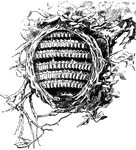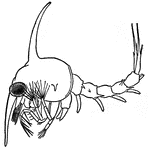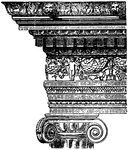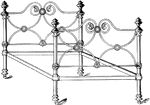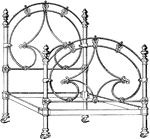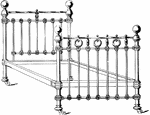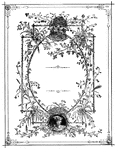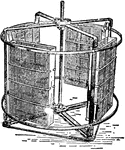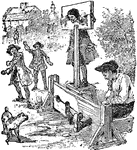
Pillory
A wooden frame designed for the punishment of offenders and criminals. This mode of punishment was formerly…

Meyer Madonna
"The Meyer Madonna. By Hans Holbein. In the Dresden Gallery. (Later Replica of the Darmstadt picture…
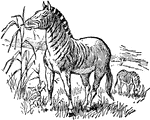
Quagga
The quagga is an extinct subspecies of the plains zebra, which was once found in great numbers in south…
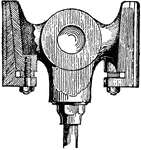
Crosshead
A beam or rod stretching across the top of something; specifically, the bar at the end of a piston rod…

Strawberry
A genus of plants extensively cultivated for their luscious fruit. They were so named from the practice…
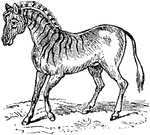
Quagga
The quagga is an extinct subspecies of the plains zebra, which was once found in great numbers in South…
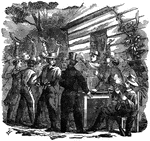
Invasion of Kansas
This illustration shows the invasion of Kansas during the controversial period of time with free and…

Triumph of Columbus
The Triumph of Columbus. A fac-simile of the original sketch by Columbus himsef, was sent by him from…
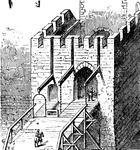
Draw Bridge
A bridge which may be drawn up or let down to admit or hinder communication, or to leave a transverse…

Pillory
A frame of wood erected on a post or pole, with movable boards resembling those in the stocks, and the…
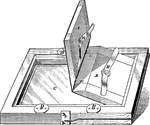
Painting Frame
"A printing frame that is well adapted to sheets not over 17 in. x 21 in. The frame is placed face downwards…
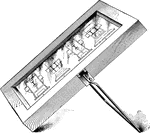
Painting Frame
"A printing frame that is well adapted to sheets not over 17 in. x 21 in. The frame is placed face downwards…
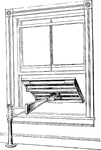
Painting Frame
"A patented frame that can be shoved out of the window and adjusted to any angle; it is made in different…
Howard's Plough
"The plough is composed of two strong iron frames balanced upon four wheels, and crossing each other…

Stewarton Hive
"A hive largely and successfully used in Scotland, it is octagonal, and the "Quinby hive" of America…
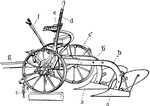
Gang Plow
Two or more plows attached to a stock or frame. Generally having wheels as a sulky plow has, with adjustable…

Common Pompano
A fish with a blunt snout and fins free of spines. Color is uniformly blueish above without dark bands…
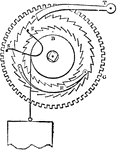
Harrison's Going-Ratchet
"The click barrel-ratchet R is set upon another larger ratchet-wheel, with its teeth pointing the opposite…

Gravity Train Remontoire
"E represents the scape-wheel turning in a minute, and e its pinion, which is driven by the wheel D…

Coal-cutting Machine
"This machine consists essentially of a horizontal piston and cylinder engine fixed upon a platform…

Slubbing Frame
"The operation which succeeds that of the drawing frame is slubbing, where the sliver has a certain…

Roving Frame
"This, which is the last required before the operations of spinning, strictly so called, commence, resembles…

Throstle
"The spinning frame, or throstle, is made with two sets of drawing rollers, one on each side. Between…
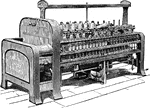
Throstle
"The spinning frame, or throstle, is made with two sets of drawing rollers, one on each side. Between…

Ball's Naturalists' Dredge
"The dredges on this pattern, used in Britain for ten years after their first introduction, about the…

Zenith Telescope
"The instrument is supported on a strong tripod, fitted with levelling screws; to this tripod is fixed…

Parting Vessel
"The parting vessels are of porcelain which, to protect them against fracture by irregular heating,…

Machine Gun
"Nordenfelt Machine Gun. 1-10, parts of frame; 11, breech plug; 12, striker; 13, extractor; 14, cartridge…
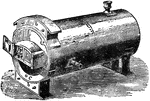
Trentham Boiler
"A very powerful and economical one, for large establishments especially. It is a modification of the…
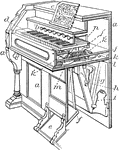
Reed Organ
A musical instrument consisting essentially of one or more graduated sets of smll free reeds of metal,…

Hosiery
"In the year 1589 the stocking-frame, the machine which mechanically produces the looped stitch in hosiery,…

Tumbler Needle
"An improvement of great importance in the hosiery trade was effected through the invention of the tumbler…

Muscular Cells
"Muscular cells of medusae (Lizzia). The uppermost is a purely muscular cell from the sub-umbrella;…

Corymorpha
"A, a hydriform person giving rise to medusiform persons by budding from the margin of the disc; B,…
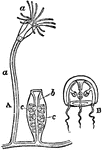
Campanularia
"Diagram of a colony of Campanularia, showing four forms of persons. A, portion of a fixed colony; a,…
Auditory Nerve
"a, the osseous septum grooved for the passage of the cochlear nerve b, which terminates by a free end…
Barometer
"A glass tube about 33 inches in length, open at one end, is completely filled with mercury, and being…

Agnostus Nudus
"Four stages in the development of the trilobite Agnostus nudus. A, Youngest stage with no mesosomatic…
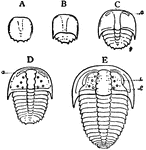
Sao Hirsuto
"Five stages in the development of the trilobite Sao hirsuta. A, Youngest stage. B, Older stage with…

Prosomatic Limb
"Comparison of the sixth prosomatic limb of a recent scorpion (B), of Palaeophonus (C), and of Limulus…

Langstroth Hive
"The typical hive of America is the improved Langstroth, which has no other covering for the frame tops…

Road-Racer
"Road-racer. A full roadster would have the handles a little higher relatively to the saddle, and would…

Womans Bike
"A lady's bicycle with gear-case and dress-guard. The rear frame of the "diamond" type is subjected…

Ball-bearing Hub
"A ball-bearing hub with outward cups. The hub-shell H is turned out of mild steel, and the cups C are…

Cup-adjusting Hub
"One end of the cup-adjusting hub, with inward bearings. The cones are formed of one piece with the…
